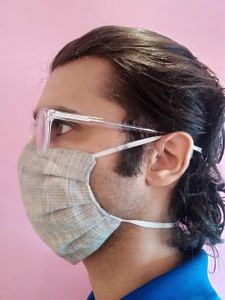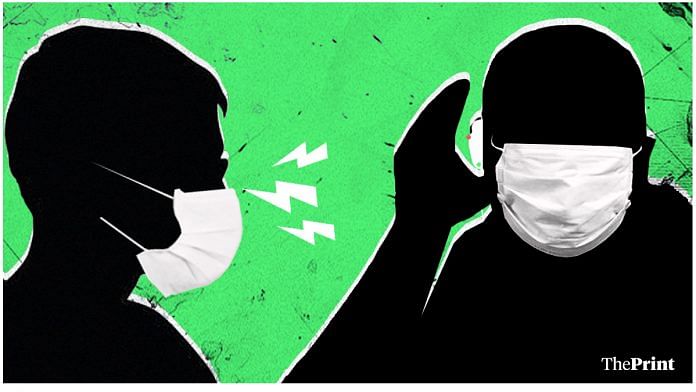In an ableist world, the needs of the differently abled are catered to as afterthoughts, if at all, and in the middle of a raging pandemic, the problem has increased manifold.
People with hearing or speech disabilities rely on lip-reading, body language, gestures and facial expressions in order to communicate, but now, the fact that everyone is wearing masks during the Covid-19 pandemic has proved to be a major barrier, and has isolated an already marginalised segment of people even more.
It has made even completing daily chores a task. “The challenges (faced by the community) are majorly seen from the immediate environment and places of daily engagement such as grocery stores and hospitals where. For example, asking for bills becomes challenging for the person as they might require the shopkeeper to write the amount and show it to them,” says Anindita Roy, a disability social worker and movement therapy practitioner.
According to a report on challenges faced by women with disabilities during the pandemic, 75 out of 82 participants, and all participants who identified as deaf, deaf-blind and hard of hearing, faced access barriers with regard to information, physical spaces, communication, digital spaces, health services, food and other essentials, and remote/digital education among other things.
The report by Rising Flames, an NGO working for the recognition, protection and promotion of people with disabilities, and Sightsavers, an international organisation working in over 30 countries to eliminate avoidable blindness, says those reliant on lip reading found extensive and necessary use of masks barriers for them in independently accessing services.
“With mask, lip reading is difficult, buying of vegetables, food, talking in gestures in difficult. Communication is tough. Misunderstanding is very normal. It is the first time I have faced something like this…I can’t ask anybody or even understand what they are saying from under the mask,” the report quotes a 31-year-old hearing impaired woman from Maharashtra.
On this Reddit thread too, people with speech and hearing problems could be seen sharing their struggles.
One user, who was admitted to a Covid-19 hospital, elaborates on how difficult it was for him to understand what doctors covered in PPE were telling him. “It’s very confusing having people in full PPE talk to you and the only expression I could see was eyes, brows and forehead. They’re saying important things about my health, and they might as well be muted cartoons.”
The problem with standard masks
Aman Misra, who runs a bookshop in Kolkata, says face masks were bothersome for more than one reason. “As a deaf person, you tend to unconsciously (or consciously) lip read people. Unless people use transparent masks this is not possible. You’re constantly going ‘What What What’ like Brett to Jules in Pulp Fiction!”
It’s not just problems with lip reading, though.
The standard masks use ear loops and are supported by the back of the ear, which can be very painful and disruptive for people who use hearing aids. They have to customise their masks to ensure the strings tie at the back of their head instead.
“There is the worry of hearing aids, spectacles and mask loops going over the same point on the ear — it does get painful after a while and I wonder why no mask manufacturer thought of this.”

One can get such masks, but they aren’t easy to procure and are more expensive than the ones readily available, which makes Misra wonder if being deaf was “a rich person’s disease”.
“Eventually, I had to get a different kind of mask specially made. I had to pay extra for the stitching of loops, so it’s the cost of a normal mask plus 70-80 bucks extra per loop set,” he explains.
For women with hearing problems who also wear a hijab, masks pose an even bigger challenge. Wearing a mask under a hijab, particularly with hearing aids (and, in some cases, glasses) can be extremely restricting.
“I wear a hijab, glasses, hearing aids and a mask. My ears ache by the end of the day, but what can you do,” a woman notes on Reddit.
But things are improving, though not fast enough. Dehradun-based National Institute for the Empowerment of Persons with Visual Disabilities (NIEPVD) has been making and distributing transparent face masks.
The institute has made 800 masks so far, and distributed 250 of them among policemen and the rest among staff members on its campus.
The Tamil Nadu government, too, has taken cognisance of the problem and partnered with local manufacturers to make transparent face masks. As part of a pilot project, the government plans to distribute 81,000 masks to nearly 13,500 people with disabilities, their families and friends.
But this isn’t enough. Devanshi Chhabra, a social worker and advocate for people with hearing problems, says these masks aren’t exclusively for those in the community, their family and friends. It’s very important that the mainstream world adopts them so that the isolation faced by those with disabilities can be mitigated, she says.
Chabbra has also taken the initiative of making transparent, affordable masks that don’t obstruct lip-reading.
“Masks with a clear, plastic portion around the lips are not readily available in India for all,” she tells ThePrint, adding that this impacts those who can’t hear or speak, and who rely on facial expressions to relay their thoughts and needs.
Also read: Disabled Indians can’t be afterthought in Covid. Disability secys needed in all ministries
Increased isolation, lack of access to facilities
According to the report by Rising Flames and Sightsavers, all the interviewees felt an increased sense of isolation. More than 50 per cent said as they were not able to work, study, or step out of their houses, and it has led to increased tension within families because they aren’t used to being home all the time.
Confinement at home also makes the community, especially women, vulnerable to domestic abuse. Many have cited lack of privacy and accessibility to reach out to peers for support or redressal.
Lack of communication also means many disabled people fail to grasp the gravity of the situation or know about the lockdown — especially in rural and remote areas.
“When the pandemic started, news didn’t reach people who are from interior communities and it was through different organisations working in field who helped in spreading awareness about the situation.
“People in urban areas do have access but most of the communities do not have inclusive setting for receiving apt information timely,” Roy explains, adding that people with hearing and speech impairment have their own ways of understanding messages from any media.
It has also been observed that for communities with no access to visual media and lack of awareness, necessary information about the pandemic reached late.
There have been cases where staff at quarantine centres failed to understand if the differently abled members needed food, water or were feeling sick, a PTI report quotes a social worker as saying.
Also read: India pioneered TV education, but smartphone classes during Covid let down its poor students
Impact on education
Lack of access extends to digital spaces as well, leading to large-scale dropout rates of students with disabilities. According to a report by Swabhiman, an Odisha-based NGO working for people with disabilities, 43 lakh people with disabilities might drop out of school since they aren’t able to cope with online education.
“There is lack of accessible digital spaces for education as states with larger number of disability population living in rural areas do not have access to proper internet connection, smartphones, laptops/desktops for online classes. The pace of learning for students with disabilities has been deeply affected because of remote learning,” Roy explains.
Throwing more light on this problem through personal experiences, Chabbra says the community has been excluded from online lectures.
“Even though some classes do have access to sign language interpreters, it has posed a challenge for the hard of hearing community. How is a deaf/HoH person supposed to understand when the internet connections are weak, no captions are available, voices muffle or lighting is poor?”
Without regular classes, disabled students are also at increased risk of violence at home. A teacher explains in this report how children would take their educators in confidence to report violence, if any, that they were facing. However, in the present times, they are reluctant since parents are around all the time.
To mitigate the isolation faced by the community in the current environment, Roy says, certain small steps can go a long way.
“Along with the guidelines of Covid-19, a detailed guidelines on easy communication should be created for the general public which in turn will help family members/immediate environment of the people with disabilities to be inclusive and accessible,” she suggests.
Large-scale employment of sign language interpreters, disability activists and accessibility experts, among others can help create a bottom-top or top-bottom approach in awareness generation, she adds.






